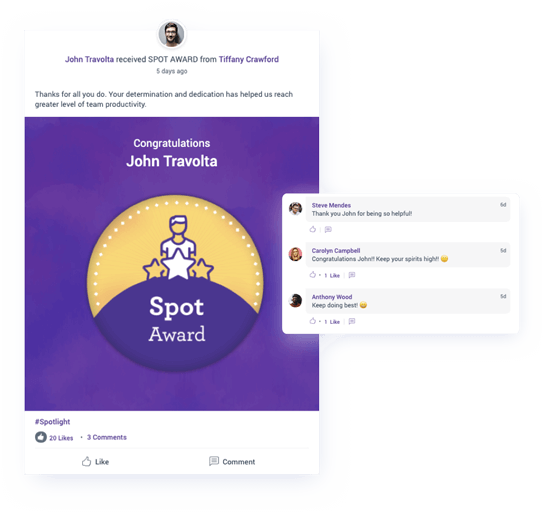9 Ways To Make Recognition At Work Truly Unforgettable In 2024
Employee appreciation is more than just a checkbox exercise. If you want to foster a value-driven, vibrant, and productive culture, offering authentic recognition at work should be at the top of your priority list.
The benefits of employee recognition at work cannot be overstated. When appreciation is regarded as a core value by a company, factors such as employee engagement, productivity, and employee experience improve automatically.
But the question is, are these businesses doing things the correct way or just following the crowd? Do your employee recognition efforts live up to the expectations of the employees?
But first, we have to clear about:
What Do Employees Actually Want?

For decades, social scientists have attempted to determine what distinguishes an employee who is motivated to go above and beyond from a disengaged employee.
In an HBR article, multiple social and people management experts highlighted what makes an employee go above and beyond for the job they do.
They used a modified version of Maslow's hierarchy of needs to zero in on three simple desires shared by employees:
- Career: Having a job that fulfills your professional goals.
- Community: Building strong relationships within your work circle.
- Purpose: Your job should be a source of passion, happiness, and peace.
What Does Giving Recognition At Work Mean?

Giving recognition at work should not be cheesy or vague. It should be an act of appreciating your employee in a way that makes them see how much you value their contributions.
Offering some form of recognition at work is not a novel concept. Getting a watch based on the years of service, a card for Thanksgiving, or a gift card for Christmas are a few common examples of recognition at work.
But are these occasional, once-in-a-blue-moon gestures enough to keep employees motivated? Of course not.
Recognition At Work: The Challenges Of The Modern Work Environment

Employee recognition, like all other concepts, has evolved quite a bit.
The war for talent is real, and employees are now choosing their employers (not the other way round).
Employees now have huge expectations from their employers. To meet the changing needs of the people and match the expectations of the new generations in the workplace, it only makes sense to re-evaluate the rewards and recognition efforts of the organization constantly.
Not surprisingly, the dominant groups in the workforce (Millennials and Gen Zers) are difficult to please. They don't value recognition unless it's genuine and memorable.
They feel they are entitled to receive recognition at work for a job well done. Giving recognition in a way that appeals to these employees is essential for attracting, retaining, and satisfying them.
If all the points mentioned above aren't enough to cement the benefits of employee recognition, here are a few statistics for you:
- 89% of people believe employee recognition programs help with the employee experience. (Source: SHRM/Globoforce Survey)
- 23% of employers offered additional recognition programs to stay competitive in attracting and retaining talent. (Source: SunTrust)
- Employees cited "lack of appreciation" as the third most popular reason for quitting their company. (Source: Achievers)
- About 50% of senior managers view recognition as an investment. (Source: Maritz & WorldatWork)
- About 85% of professionals prefer a simple "thank you" as a form of recognition for their day-to-day work. (Source: Deloitte)
Introducing 9 Amazing Ways Employees Want To Be Recognized At Work:

When recognition at work is given frequently, employees have no qualms about going the extra mile.
But here's the kicker. It's not enough that employers recognize employees for the good work they do. The appreciation must also be done in the right way.
If you're unsure how to proceed, here's a list of some simple ways to make recognition at work more impactful:
1. Boost Peer to Peer Recognition
We, humans, are essentially social beings. We have an inherent need to be appreciated and treated well by the people in our surroundings.
Your employees spend a significant amount of time at work with their team. They have better interpersonal relationships with their peers than, say, managers or other employees. Thus, employees naturally value recognition when it comes from a member of their peer group.
In such a situation where peer interactions are high, and teamwork is a necessity, peer recognition at work is something that companies must promote. Whether it’s all-hands meetings or spirit week celebrations, companies should encourage their employees to recognize and praise their peers' efforts.
To sum up, employees share stronger bonds with their peers than with their managers. They also feel that sometimes the appreciation from managers is forced and not genuine.
On the other hand, it is considered more meaningful when recognition comes from peers. Companies should facilitate a culture where peer recognition becomes frequent and natural.
2. Leverage Social Media
Why social media, you ask? Because everyone's doing it.
Unless something is shared on social media, it is not considered noteworthy for today's generation.
And it makes sense to some extent. Being noticed on social media by a company with tens of thousands of followers has a certain allure.
Social media recognition gives your employees the impression that they are truly in the spotlight. Also, flaunting hard-earned appreciation for their excellent work becomes easier on these platforms.'
For example, even the "employee of the month" or similar recognition ritual will immediately become more meaningful when you post a picture of them on the company's social media handle.
A big plus about going to social media for recognition is gamification. Employees can nominate or vote among themselves for important awards and recognition.
- You can reward the team or department that shows great achievements on social media. It encourages employees to work together as a team and not just as individuals all the time.
- When a team or department reaches a significant milestone, you can highlight their achievements on social media.
- You can use social media to turn otherwise dull team recognition announcements into interactive social media posts.
- Another great way of recognizing employees is through cloud-based internal employee recognition programs.
Companies now have R&R platforms that can function as mini social media platforms. This is where employees can exchange birthdays or work anniversary wishes, celebrate occasions such as Employee Appreciation Day, deliver on-spot compliments, and so much more.
It is also becoming simpler to integrate reward points into such platforms. Managers can improve the overall potency of the recognition process by introducing new incentives and virtual leaderboards.
Other employee recognition ideas that work well on social media include:
- A letter of excellence written by a leader, team member, or manager to recognize special accomplishments and milestones.
- A monthly online newsletter with special mentions and shout-outs to all the monthly award winners.
- A virtual wall of fame for the recognition-worthy remarks every week.
3. The Era of Instant Gratification
Delayed recognition is as good as denied credit for today's multigenerational workforce.
The millennials and the Gen Zers dominate the workforce and are rightly termed "impatient" and "fast-paced." They want to get their job done quickly, expecting instant recognition for the same.
Recognizing achievements in real-time or trying to schedule them as close to the actions you're rewarding reinforces the behaviors you want to encourage. Also, as a result, employees become aligned with broader company goals.
When employees know that you will praise them and their efforts wouldn't go unnoticed, they are more likely to take up challenges and continue growing. It empowers them by giving them an extra boost of confidence.
Additionally, expressing interest in their professional development, sending them emails about their progress, and assisting them in their journey help you reach the broader company goals faster. It is a definite win-win situation for both employers and employees.
4. Gift of "Time-off"
Since flexible work hours are an initiative that is almost certain to become a permanent option in the near future, why not use it to recognize your employees?
According to a Deloitte survey, 32% have consistently prioritized work over family/personal commitments. Meanwhile, while one-third of executives ranked work-life balance as one of their top five priorities, only one in ten believed they effectively dealt with it.
While work schedules are getting busier, personal time is getting shorter. Striking the ideal balance between work, career, family, and fun has been identified as the most difficult challenge for employees in 2020 and beyond.
To make recognition truly meaningful, you must break off from traditional practices and adopt modern ones.
When an employee goes above and beyond to get a particular piece of work done, you can give them an extra day or two off or a short paid holiday to show them that they truly deserve a pat on the back.
Doing so will boost their motivation and, at the same time, present a caring image of the company.
Burn-outs have become common, and they are more susceptible to illness and other health conditions. These often lead to high absenteeism, low productivity, and higher company health costs.
5. The Power of Personalization in Rewards and Recognition
Personalization is not a trend; it's a marketing tsunami.
~ Avi Dan
Everybody loves a personalized approach. But when it comes to motivating employees, there are two main factors:
And there has been this constant debate between Extrinsic vs. Intrinsic motivation. Still, the idea is to find the balance while recognizing your employees. This is where personalization steals the show!
Employees have different expectations and goals to achieve in their career trajectory. Rewarding employees doesn't need to be a one-size-fits-all solution.
To properly recognize your employees' efforts, you must first get to know them and understand what motivates them.
Impersonal rewards are perceived as hollow and often do more harm than good.
But the question is how to personalize rewards? How to find out what makes your employees feel good?
a. The first approach would be to ask them via surveys and emails.
A quick survey before the recognition program can help you learn a lot about their preferences. You can also provide them with a plethora of reward options to choose from.
b. The next solution would be a point-based reward system.
When it's difficult to find a reward for a specific person, a point-based rewarding system can come in handy. In a point-based rewarding system, each employee is a part of an employee rewards program where management can award points as gifts or rewards to their employees.
The employees can redeem these points and purchase goods/services from brands from different categories (like merchandise, travel, lifestyle, etc.) available on the platform.
You can leverage an appreciation program for the employee that shows positive qualities in the workplace. Points could be awarded to the employee for simple tasks like assisting their colleagues with punctuality or other attributes.
Vantage Circle offers a unique employee recognition program, Vantage Rewards.

Vantage Rewards is an AI-powered recognition platform that offers a global rewards catalog where your employees can redeem their reward points for gift cards, experiences, merchandise, and more.
6. Public Recognition In The Workplace
Public recognition may appear to be a cliche until you consider that not all good performers are well known even within the company culture.
When you have a team player whose contributions aren't even acknowledged by the rest of their colleagues, it quickly becomes a flaw in your employee recognition program.
So, to ensure that no great work goes unnoticed or unappreciated, make sure that when any kind of recognition happens, it happens in a public way.
To do that, you can either go the classic way of publicly handing out the award.
Or there is also an easier way of using a rewards and recognition platform that offers a social feed feature. Vantage Rewards is one such platform that offers employees the chance to share, comment, like, and appreciate their peers on a real-time social dashboard.
7. Verbal Recognition > Non-Verbal Recognition
In a 2018 Deloitte survey, 54% of employees said they preferred a verbal thank-you, and 31% preferred a written thank-you when recognized for day-to-day accomplishments.
An act of appreciation is only meaningful when the words are genuine. When you shake your employees' hands and share a few words of gratitude, it means far more to them than any hollow award.
Thus, if you want to show employees that you care about what they do, don't be shy to thank them personally for all the blood, sweat, and tears they've put up.
8. Be Specific
The work environment can be a difficult place to navigate. When you mix in the act of receiving recognition at random, it can be hard to figure out how the employee recognition process works.
When employee recognition is made specific, people know exactly what they are getting recognized for. That makes it easier for them to emulate those said behaviors over time and understand what is expected of them.
To make recognition in the workplace meaningful, it is critical to link the appreciation process to the behaviors you want to see in your employees.
That means no more "Good job, team."
It means being more specific with your words of appreciation, such as:
John, your client demo was a huge success. They were blown away by your calm demeanor and problem-solving abilities. Good job!
9. Recognize Efforts. Not Just Wins.
In most cases, appreciation is offered only when an employee achieves something great. But if this is common in your company culture, stop right away!
The ultimate goal of an employee recognition program is to gradually but steadily increase employee engagement levels. But once you start recognizing only the successes and not the efforts, all of your efforts to engage them will be in vain.
Your employees should be able to see that their efforts, hard work, and dedication are celebrated just as much as their successes. This is how you show that you care about them beyond monetary gain.
Final Takeaway: Recognition At Work Is Integral To Your Company Culture

Traditional employee recognition programs breed cynicism and apathy over time. They also come across as a one-size-fits-all approach (mostly done to make the organization look good).
But the modern workforce expects their employee recognition program to be tailored to them, given for something that matters.
I hope this article helped you understand the upcoming trend in employee recognition practices. If you have any more suggestions or inputs, do let us know. I'm excited to hear from you!


















